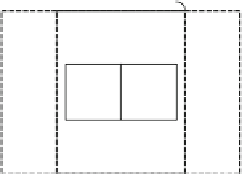Graphics Reference
In-Depth Information
a
b
Fig. 11.5
Illustration of central-quarter fractional motion estimation algorithm. The
white, light-
gray, dark-gray circles
are the best integer-pixel candidates, half-pixel candidates, and quarter-
pixel candidates, respectively. The numbers represent the passes. (
a
)Two-stepFME;(
b
) Central-
quarter one-pass FME. The 25 candidates insides the
dark square
are processed in parallel
b
N
SR
H
-1
a
N
Search Region 0
SR
H
-1
N
N
Search
Region 0
Search
Region 1
CTU 0
SR
v
-1
CTU 1
SR
V
+N-1
CTU 0
CTU 1
Search Region 1
N
W+SR
H
-1
Fig. 11.6
The schemes of searching range data reuse (
a
)LevelC(
b
)LevelD
parallel. The interpolation can even be simplified to bilinear interpolation [
39
]for
further cost reduction. The motion compensation is done after FME is finished. A
total of 6:084 % BD-rate increase or equivalently 0:194 dB BD-PSNR degradation
is observed for the described changes to IME and FME.
11.3.2
Reference Memory Subsystem
The major design challenge in supporting inter frame encoding in HEVC is the
large bandwidth requirement for reference frame access. This issue will be discussed
from both system-level and module-level views. From a system-level view, motion
estimation in high resolution causes excess external bandwidth requirement. The
huge memory bandwidth comes from loading the data of candidate blocks. To
reduce the memory access, data reuse schemes such as Level C, Level D, and Level
C
C
are proposed [
8
,
22
,
38
]. A cache-based scheme to reduce the required SRAM
size with similar external bandwidth as above is proposed in [
40
], at the cost of
variable latency. For Level C scheme, the data is reused among search range of































































































































